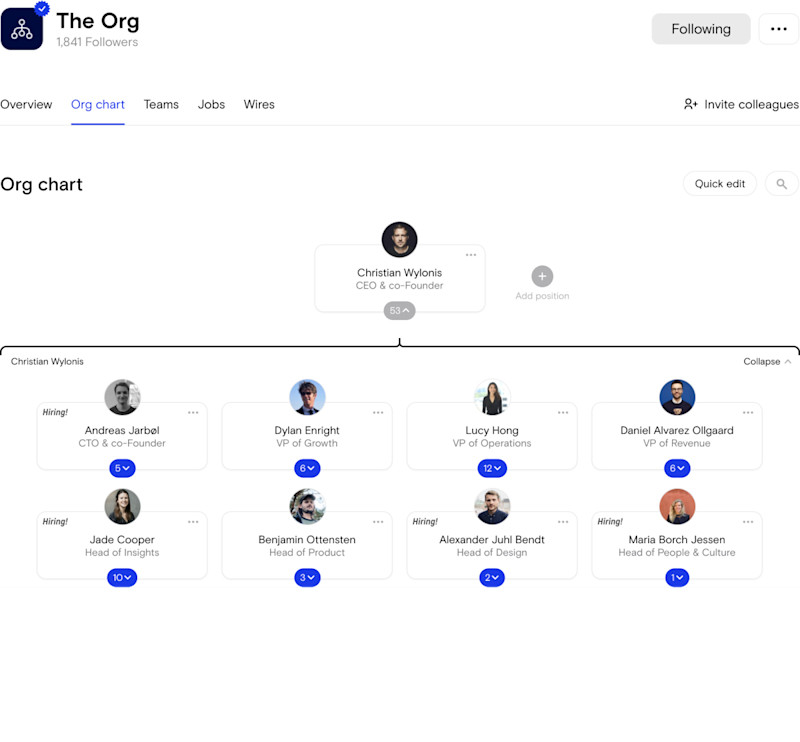- Iterate
- Organizational Structure
- How to Build an Org Chart from Scratch
Table of contents
No matter the industry, all companies can benefit from an organizational chart. These charts outline company structure, work to manage workloads effectively and increase efficiency in the workplace.

No matter the industry, all companies can benefit from an organizational chart. These charts outline company structure, work to manage workloads effectively and increase efficiency in the workplace. Creating an org chart for your business will help operations run smoother and prepare you for exponential growth in the future.
Popular Types of Org Charts
While there are several org chart models out there, here are three of the most popular types:
- Hierarchical Org Charts: This is the most common type of org chart. Hierarchical org charts represent the power structure of a company. You’ll typically see the CEO at the top with the C-Suite underneath them, followed by the middle levels of management, down to the newest hire.
- Flat Org Charts: Flat org charts are used in company’s that don’t have a middle management structure. They’re best suited for start-ups in early or small businesses with little hierarchy.
- Matrix Org Charts: A matrix org chart works well with employees reporting to multiple managers across multiple teams. A matrix org chart maintains communication and clear expectations across company divisions to keep everything functional and orderly.
To get more insight into org charts and how they work, see the guide below:
What to Consider When Building Your Org Chart
What Should An Org Chart Accomplish?
Even the most simple of org charts should accomplish the following:
- Outline roles and responsibilities within the organization
- Simplify the onboarding process for managers and new hires
- Help employees understand who to report to
- Allow for future growth and change
- Include employee details and pertinent information
You also need to think about how your org chart will help your company achieve its goals. Think about where you want your company to be in five years down the line. How about ten years? Your org chart is the backbone of your organization, and a solid company structure will make reaching your goals a reality sooner than later.
The workflow of your company should also contribute towards efficiency and reaching goals. For instance, will the org chart you create organize your employees and teams in a way that encourages collaboration? Can your employees quickly build relationships with team members outside of their departments? All of these small decisions will add up to create an org chart that accurately reflects your company’s framework.
How to Build Your Org Chart
Now that you know what your org chart should include, it’s time to get down to business. Building your org chart can be broken down into four steps:
1. Choose Your Org Chart Type
Earlier, we discussed the different types of org charts used by companies. Depending on your organization’s unique needs, you may find that one kind of org chart fits your company better.
For example, a company with a single branch in one location will find that a standard hierarchical model works best. On the other hand, a smaller company with fewer members might feel that a flat org chart is better suited for outlining member’s roles in the early stages.
Create your own free org chart today!
Show off your great team with a public org chart. Build a culture of recognition, get more exposure, attract new customers, and highlight existing talent to attract more great talent. Click here to get started for free today.
2. Identify Responsibilities in the Company
Once you’ve picked a type of org chart, your next task is to start identifying responsibilities in the company. At this point, it’s best to only focus on where the duties fall into place within the company. This helps you to avoid building teams and overall organization structure around certain people.
Just think, if you form an entire team around a manager in the company, and they end up leaving, where does that leave the remaining employees? Instead, think about your business growth strategy and build your structure around that. It might help to ask yourself questions such as:
- What kind of reporting structure do roles in the company have?
- Will key roles do I need to include in the org chart?
- How large do teams in the company need to be?
- Can this organizational structure adapt to growth comfortably?
Answering these questions during the structuring process will help you build an org chart that can grow with your business with minimal issues.
3. Structure Teams for Efficiency
Whether you create your org chart in the early stages of your business or after a few years, you should structure it with efficiency in mind.
As your company gets larger and onboards more people, you want to maintain a healthy ratio of people reporting to managers. However, no matter how organized they are, even the best manager can only supervise so many team members before things get out of hand.
If a team manager has too many people reporting to them, it can slow down processes within the company. Employees may start to feel that they aren’t recognized, ruining the morale of a team. To avoid this, structure your teams in a way that ensures managers can give each member of their team the time and attention they need to flourish.
To find out more about how an org chart contributes to better company culture, see here:
4. Make Your Org Chart Accessible
Your org chart should be accessible and easily shared both in and out of your company. Everyone having access to the org chart helps promote communication and camaraderie in the organization.
It will even help remote workers to feel connected to people working on-site, further improving the company culture. Not to mention that potential hires can easily see where they would fit into your company at first glance. This assists in simplifying your hiring process and ensures that you only attract top-tier talent.
Need more motivation to build an org chart for your company? Check out how an org chart will make your job (and life!) easier here:
How a Public Org Chart Makes Your Job Easier
If you’re ready to start building your company’s org chart, click here to sign up for the Org.
Create your own free org chart today!
Show off your great team with a public org chart. Build a culture of recognition, get more exposure, attract new customers, and highlight existing talent to attract more great talent. Click here to get started for free today.


The ORG helps
you hire great
candidates
Free to use – try today
